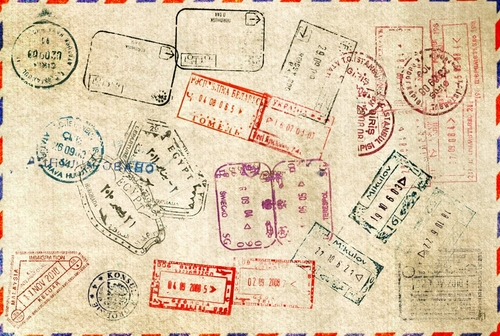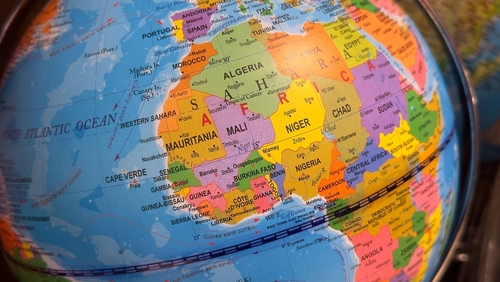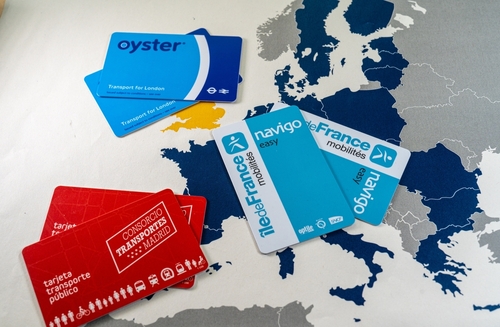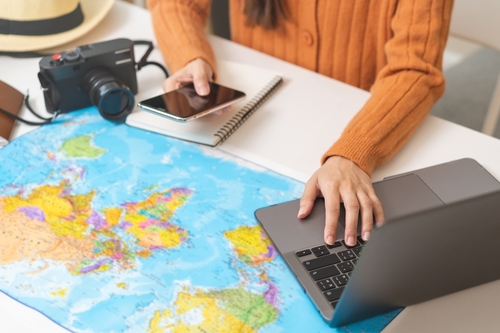Every world traveler has their own way of commemorating their trips. Some of us love magnets or decorative shot glasses. Others lean toward postcards and t-shirts. But have you ever considered collecting unique mementos that go beyond the typical items in a tourist shop?
At Remitly, we love thinking outside the box. In this article, we’ll walk through government-issued travel souvenirs that can serve as authentic, official keepsakes that tell genuine stories. Many of the items and mementos in this article are free or low-cost, making them accessible to all travelers—even those on a budget. Read on to learn how to get passport stamps, official documents, commemorative items, and other legitimate government souvenirs from around the world.
What are government-issued travel souvenirs?
Governments are giving out travel souvenirs? Well, they’re not really handing out baseball caps and pins, but governments do provide keepsakes that can commemorate your travels. Government-issued travel souvenirs are official items, documents, or stamps provided by government agencies.
These government-issued souvenirs are special and different from traditional tourist merchandise because they cannot be commercially purchased. Instead, they represent a process that you went through or a destination that you visited—officially.
Government-issued keepsakes are usually personal and often have no real commercial value. In some cases, they’re difficult to get. For these reasons, they hold special significance for travelers and collectors.
A few common examples of government-issued souvenirs are passport stamps, entry permits, and official certificates.
Passport stamps: the classic collectors’ items

When you enter a foreign country, you’ll probably be greeted by a long line of weary but excited travelers. Phones are slipped into pockets, cameras are put away, and children are shushed. You’re at a border crossing and about to interact with foreign government officials.
You’ll present your passport and any additional entry documents. Maybe you’ll have a short conversation about the length of your stay and your reason for entering the country. Typically, the border patrol agent will issue a stamp in your passport with a satisfying, final thud. You’ve entered a new country—and collected a new government-issued souvenir!
Unique and artistic stamps
First and foremost, passport stamps are functional. They officially note the date of your entry into a foreign country. However, many passport stamps are also designed to represent the country. They’re often unique and artistic, making it a joy to flip through a well-used passport. For example, Japan’s passport stamp features Mount Fuji, while Switzerland’s bold, red stamp is emblematic of the country.
Commemorative stamps
Many countries, including those in the European Union, are moving away from traditional physical passport stamps as border crossing procedures shift towards digital systems. However, aside from official government passport stamps, some countries offer commemorative stamps that you can collect to remember your trip.
In Spain, hikers challenging themselves on the Camino de Santiago can be issued a “passport” to collect stamps from bars, restaurants, hostels, and churches along the route. Similarly, South Korea sponsors a “Korean Heritage Passport Tour,” which encourages visitors to collect stamps from cultural sites across the country.
Consider researching your destination before you go to see if there is a commemorative passport stamp program you can participate in. Keep in mind, commemorative stamps should never be placed in your official government-issued passport, as they can potentially invalidate the document.
Sharing your passion for passport stamps
Passport stamps have been in use since border control procedures became normalized during World War I. These stamps offer a look into both the culture and history of different countries. If you’re fascinated by passport stamps and saddened by the shift to digital technology, consider requesting a copy of your passport record through the US Department of State.
Certificates and official permits

In addition to passport stamps and entry procedures, some locations have additional entry requirements. This is often because the area is protected, or the number or type of visitors is limited.
On the other hand, some destinations are difficult to get to, physically taxing, or special in other ways. These locations often have certificates that you can get to commemorate having been there.
Unique destinations
Crossing the Antarctic Circle is no small feat. If you do it, you can get an Antarctic crossing certificate. This is an unofficial, commemorative certificate that commemorates this significant achievement. You can get your Antarctic crossing certificate or “Red Nose Certificate” from Tiffany Publishing.
Similarly, crossing the equator overland is an event worth commemorating. It’s something that not many people do in their lifetimes. A Certificate of Equator Crossing, also known as a Shellback Certificate, was originally a way to honor sailors who crossed the equator for the first time. Some navies and sailing companies continue to have traditions around first equator crossings. If you make the crossing, you might look to get a certificate for yourself.
A connection to the great outdoors
If you love being immersed in nature, you’ll likely have many opportunities to collect government-issued souvenirs. A visit to a protected location, like a national park, typically requires a paid permit. These park permits and entrance documents can serve as keepsakes. Additionally, paper copies of fishing and hunting licenses can double as travel mementos.
Taking on the challenge of a famous peak like Mount Everest? Many famous peaks, like those in Nepal, Pakistan, and India, require an ascent permit. Consider saving these so that you can say, “I summited this mountain and all I got was this piece of paper.”
Currency and legal tender

Exchanging currencies to head to a foreign country always provides an interesting look into the culture and priorities of a place. Who is featured on the currency? What landmarks are shown? If you end your trip with a spare bill or coin, consider holding onto it to remember the trip instead of exchanging it back to your local currency.
Special editions and commemorative pieces
In some cases, government mints offer special edition coins for travelers. These are typically not coins that would be used to make purchases. Instead, they are purposefully designed as a way to remember your travels. These are usually offered on a limited basis directly from government mints and central banks.
Central bank visitor programs
Get rich in culture and experience by diving even deeper into the world of foreign money. Check if the central bank of your travel destination offers tours or visitor programs. These are often ways for researchers and the public to engage through public-facing lectures and events that educate about the bank’s function and heritage.
Transportation and infrastructure keepsakes

Taking public transportation instead of a private car is not only good for the environment; it’s also good for souvenir hunters.
Entry passes and tolls
Metro cards, transit passes, and transportation tokens can be saved as travel mementos. Not only will these items say “I’ve been there,” but they’ll also mark a specific point in time. For example, the NYC Subway System used to operate with tokens. Then, it switched to cards. Now, many stations can be accessed by tapping your own credit card or even your phone. If you’re in a city that has a public transit system that still issues some type of entry item, save it!
If you’re on a road trip, toll receipts and highway passes from scenic routes can also be framed or slipped into a scrapbook to highlight your travels.
Commemorative items
Some government transport authorities offer special commemorative items. Sometimes the sale of these items even helps fund the transit system. This memorabilia is often offered at official transit museums or in shops located in bigger transit stops or hubs.
Tips for collecting government travel souvenirs

By now, you’re probably wondering how to get your hands on these government-issued keepsakes. There are a few things to keep in mind both before your travel and during your trip if you’re looking to maximize your chances of collecting these mementos.
Research before you travel
Whenever you travel, it’s best to start with some advanced research and planning. This helps you prepare for your trip and get the most out of it. This rule applies to souvenir hunting as well.
Before your trip, check out government tourism websites to see if your destinations have any official souvenir programs. You can also contact embassies or consulates for information about any special or collector’s items.
If you’re most interested in passport stamps and similar documents, research the border crossing procedure before your travels to maximize stamp opportunities. For example, most countries in the European Union have shifted away from physical passport stamps. However, if you enter through Ireland or Cyprus, you’ll still get one!
Best practices at your destination
If you’re on the hunt for official, government-issued souvenirs, there are a few tips and tricks you can use to collect as many as possible—and keep them in tip-top condition, even if they’re floating around the bottom of your backpack.
- Politely make a request
In some scenarios, stamps and documents are optional. If you don’t receive a physical passport stamp at a border crossing, it is okay to politely request one from the border control agent. Just keep in mind that if you are denied a physical stamp for whatever reason, it’s not worth it to press the issue.
- Plan for preservation
Many government-issued souvenirs are paper-based. As you plan your travels, take a moment to think about the preservation of your mementos and keepsakes. How will you keep them flat and unbent? How will you keep them dry in potentially wet conditions? Including a little plastic container or folder on your packing list can help you collect keepsakes and get them home safely.
- Make purposeful visits
Collecting government-issued souvenirs is a fun challenge that helps you get out and involved with the locations you’re visiting. Consider stopping by government buildings, mints, and official tourist centers to see what documents you can access. Have a local address? Pop into a public library to see if they’ll issue you a card!
Legal considerations
As you select documents and keepsakes to build your collection, keep in mind that some items are not legal to save. For example, some official government documents must be returned, including lost or stolen passports, expired or canceled documents that contain valid visas, and EU emergency travel documents, which must be returned to their issuing authorities.
In addition to these official documents, there are some systems that benefit from the return or reuse of certain items. Some metro systems make use of reusable entry cards or tickets, rather than disposable ones. It’s best for the system and the environment if you contribute to the efforts to reduce waste or reuse items.
When you have a document or item that should be returned or surrendered, you can photograph it for your records and collection. In general, it’s always best to respect local laws and regulations. If you’re unsure about a particular item, inquire with the issuing authority.
Start building your collection today
Anyone can purchase a shirt or mug, even people who have not been to that particular place! But a government-issued travel souvenir is a unique and authentic keepsake that says, “I’ve really been here.”
As you plan your next trip, consider keeping these collectible opportunities in mind. Plan in advance what sort of souvenirs you’re looking to collect, and prioritize getting one from each city or country you travel to. Before long, you’ll have plenty of stories to tell, with the government-issued keepsakes to back them up. Happy traveling!
FAQs
Will I have to turn in my expired passport and lose my stamps if I renew?
No. When you renew your passport, you’ll have to present your old one. However, it will be returned to you with a cancelled stamp or a hole punched through it to indicate that it is no longer valid.
When is the European Union phasing out passport stamps?
Countries in the Schengen Area began phasing out physical passport stamps on October 12, 2025 for non-EU nationals. These countries are shifting towards a digital Entry/Exit System (EES) that will be fully operational by April 10, 2026. If you’re looking to get physical passport stamps from a country in the Schengen Area, book your travel now!
How can I display all of my travel souvenirs?
Although plenty of people store their keepsakes in a shoe box under their bed, there are other ways to display your travel mementos. Consider a scrapbook or album that can be thumbed through as you tell stories of your trips. Alternatively, you can create a collage and frame your items to display on the wall.